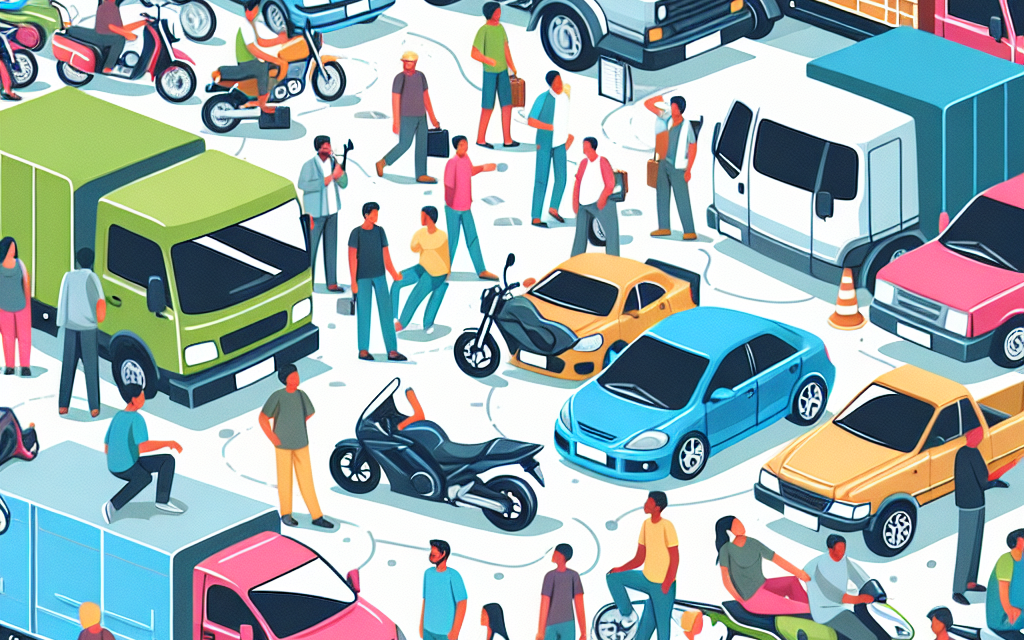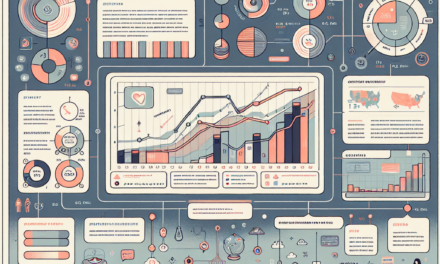“Driving Tomorrow’s Trends: Uncovering Insights in Auto & Transport Markets.”
Introduction
Auto & Transport Insights: Market Discussions provides a comprehensive analysis of the automotive and transportation sectors, focusing on emerging trends, consumer behavior, and technological advancements. This platform serves as a vital resource for industry stakeholders, offering in-depth discussions on market dynamics, regulatory changes, and competitive strategies. By leveraging expert insights and data-driven research, it aims to equip businesses with the knowledge needed to navigate the evolving landscape of mobility and transportation.
Electric Vehicle Market Trends
The electric vehicle (EV) market has experienced significant growth and transformation in recent years, driven by a confluence of technological advancements, regulatory support, and shifting consumer preferences. As the world grapples with the pressing need to address climate change, the automotive industry is undergoing a profound shift towards electrification. This transition is not merely a trend; it represents a fundamental change in how vehicles are designed, manufactured, and consumed.
One of the most notable trends in the electric vehicle market is the increasing investment in battery technology. As the heart of any electric vehicle, batteries play a crucial role in determining performance, range, and overall consumer acceptance. Recent innovations have led to the development of more efficient lithium-ion batteries, as well as the exploration of alternative chemistries such as solid-state batteries. These advancements promise to enhance energy density, reduce charging times, and lower costs, making electric vehicles more accessible to a broader audience. Consequently, as battery technology continues to evolve, it is expected that the range anxiety that has historically plagued potential EV buyers will diminish, further accelerating market adoption.
In addition to technological improvements, government policies and incentives have significantly influenced the electric vehicle landscape. Many countries have implemented stringent emissions regulations and ambitious targets for phasing out internal combustion engine vehicles. For instance, several European nations have set deadlines for banning the sale of new gasoline and diesel cars, thereby creating a clear pathway for the transition to electric mobility. Furthermore, financial incentives such as tax credits, rebates, and grants have been introduced to encourage consumers to make the switch to electric vehicles. These measures not only stimulate demand but also signal to manufacturers that the future of the automotive industry is electric.
Moreover, the competitive landscape of the electric vehicle market is rapidly evolving. Traditional automakers are increasingly investing in electric vehicle development, often reallocating resources from internal combustion engine projects to focus on electrification. This shift has led to the emergence of new models that cater to various consumer segments, from compact cars to luxury SUVs. Additionally, new entrants, including technology companies and startups, are challenging established players by offering innovative solutions and unique business models. This influx of competition is fostering a dynamic environment that encourages continuous improvement and diversification within the market.
As the electric vehicle market matures, consumer attitudes are also shifting. Early adopters have paved the way for broader acceptance, and as more individuals experience the benefits of electric vehicles—such as lower operating costs and reduced environmental impact—mainstream consumers are beginning to embrace this technology. Furthermore, the growing availability of charging infrastructure is alleviating concerns about the practicality of owning an electric vehicle. Public and private investments in charging networks are expanding access, making it easier for consumers to charge their vehicles at home, work, or on the go.
In conclusion, the electric vehicle market is poised for continued growth, driven by advancements in technology, supportive government policies, and evolving consumer preferences. As the industry adapts to these changes, it is essential for stakeholders to remain vigilant and responsive to emerging trends. The future of transportation is undoubtedly electric, and the ongoing discussions surrounding market dynamics will play a pivotal role in shaping the trajectory of this transformative sector. As we move forward, the collaboration between automakers, policymakers, and consumers will be crucial in realizing the full potential of electric mobility.
Impact of Autonomous Driving on Transportation
The advent of autonomous driving technology is poised to revolutionize the transportation landscape, fundamentally altering how individuals and goods are moved. As this technology continues to develop, it is essential to examine its multifaceted impact on various aspects of transportation, including safety, efficiency, and urban planning. One of the most significant benefits of autonomous vehicles (AVs) is their potential to enhance road safety. Statistics indicate that human error is responsible for approximately 94% of traffic accidents. By removing the human element from driving, autonomous systems can significantly reduce the incidence of collisions, thereby saving lives and decreasing the economic burden associated with traffic-related injuries and fatalities.
Moreover, the integration of advanced sensors and artificial intelligence in AVs allows for real-time data processing and decision-making, which can lead to more efficient traffic flow. For instance, autonomous vehicles can communicate with one another and with traffic management systems, optimizing routes and reducing congestion. This interconnectedness not only improves travel times but also minimizes fuel consumption and emissions, contributing to a more sustainable transportation ecosystem. As cities grapple with increasing populations and the corresponding rise in vehicular traffic, the efficiency brought by autonomous driving could alleviate some of the strain on urban infrastructure.
In addition to safety and efficiency, the rise of autonomous driving is likely to reshape urban planning and development. As AVs become more prevalent, the need for extensive parking facilities may diminish, allowing cities to repurpose these spaces for parks, housing, or commercial developments. This shift could lead to more walkable urban environments, fostering community engagement and enhancing the quality of life for residents. Furthermore, the reduction in personal vehicle ownership, as shared autonomous vehicles become more common, could lead to a decrease in the overall number of cars on the road. This transition may encourage public transportation systems to adapt and evolve, integrating AV technology to provide more flexible and responsive services.
However, the transition to a fully autonomous transportation system is not without its challenges. Regulatory frameworks must be established to ensure the safe deployment of AVs on public roads. Policymakers face the daunting task of creating guidelines that address liability, insurance, and ethical considerations surrounding autonomous driving. Additionally, public acceptance of this technology remains a critical factor in its widespread adoption. Many individuals harbor concerns about the reliability of AVs, particularly in complex driving environments. Therefore, comprehensive education and outreach efforts will be necessary to build trust and confidence in autonomous systems.
Furthermore, the economic implications of autonomous driving cannot be overlooked. The automotive industry is likely to undergo significant transformations, with traditional manufacturers needing to adapt to new technologies and business models. This shift may lead to job displacement in certain sectors, particularly those reliant on driving professions. However, it is also expected to create new opportunities in technology development, maintenance, and infrastructure support. As such, workforce retraining and education will be essential to prepare individuals for the evolving job market.
In conclusion, the impact of autonomous driving on transportation is profound and far-reaching. While the promise of enhanced safety, efficiency, and urban revitalization is enticing, it is crucial to navigate the accompanying challenges thoughtfully. As stakeholders from various sectors collaborate to address these issues, the future of transportation may very well be defined by the successful integration of autonomous vehicles into our daily lives. The journey toward this future will require careful consideration of technological, regulatory, and societal factors, ensuring that the benefits of autonomous driving are realized for all.
Future of Public Transit Systems
The future of public transit systems is poised for significant transformation, driven by technological advancements, changing urban landscapes, and evolving societal needs. As cities continue to grow and populations become increasingly urbanized, the demand for efficient, reliable, and sustainable public transportation options is more pressing than ever. This evolution is not merely a response to current challenges but also a proactive approach to shaping the urban environments of tomorrow.
One of the most notable trends in public transit is the integration of smart technologies. The advent of real-time data analytics and mobile applications has revolutionized how commuters interact with transit systems. Passengers can now access real-time information regarding schedules, delays, and even crowd levels, allowing for more informed travel decisions. This shift towards a more user-centric approach enhances the overall commuting experience, making public transit a more attractive option compared to private vehicles. Furthermore, the implementation of contactless payment systems has streamlined fare collection, reducing wait times and improving operational efficiency.
In addition to technological advancements, sustainability has emerged as a critical focus for future public transit systems. As concerns about climate change intensify, cities are increasingly prioritizing eco-friendly transportation solutions. Electric buses, for instance, are becoming more prevalent, offering a cleaner alternative to traditional diesel-powered vehicles. Moreover, many urban areas are investing in infrastructure that supports cycling and walking, recognizing the importance of multimodal transportation networks. By promoting a combination of public transit, cycling, and pedestrian pathways, cities can reduce their carbon footprints while enhancing the quality of life for residents.
Moreover, the concept of transit-oriented development (TOD) is gaining traction as urban planners seek to create more livable communities. TOD emphasizes the integration of residential, commercial, and recreational spaces around transit hubs, thereby encouraging the use of public transportation. This approach not only reduces reliance on cars but also fosters vibrant neighborhoods where people can live, work, and play within close proximity to transit options. As cities embrace this model, the potential for increased ridership and reduced traffic congestion becomes evident.
However, the future of public transit systems is not without its challenges. Funding remains a significant hurdle, as many transit agencies struggle to secure the necessary resources for expansion and modernization. Public-private partnerships are emerging as a viable solution, allowing for shared investment in infrastructure projects. By leveraging private sector expertise and capital, cities can enhance their transit systems while minimizing the financial burden on taxpayers.
Additionally, addressing equity in public transit access is crucial for ensuring that all community members benefit from these advancements. As cities develop their transit systems, it is essential to consider the needs of underserved populations who may rely heavily on public transportation. Ensuring that transit routes are accessible and affordable for all residents will be vital in fostering inclusivity and promoting social equity.
In conclusion, the future of public transit systems is characterized by a convergence of technology, sustainability, and urban planning strategies aimed at creating efficient, accessible, and environmentally friendly transportation options. As cities navigate the complexities of modern urbanization, the emphasis on smart technologies, eco-friendly solutions, and equitable access will shape the public transit landscape for generations to come. By embracing these trends, urban areas can not only enhance their transit systems but also contribute to the overall well-being of their communities.
Supply Chain Challenges in Auto Manufacturing
The automotive industry has long been a cornerstone of global manufacturing, but recent years have revealed significant vulnerabilities within its supply chain. As the demand for vehicles continues to rise, manufacturers are grappling with a myriad of challenges that threaten to disrupt production and inflate costs. One of the most pressing issues is the ongoing semiconductor shortage, which has emerged as a critical bottleneck in the supply chain. Semiconductors are essential for a wide range of automotive functions, from engine management to advanced driver-assistance systems. The pandemic exacerbated this shortage, as factories were forced to close and production schedules were disrupted, leading to a ripple effect that continues to impact the industry.
In addition to semiconductor shortages, the automotive supply chain is also facing challenges related to raw material availability. The demand for materials such as steel, aluminum, and lithium has surged, driven by the increasing production of electric vehicles (EVs) and the global push for sustainability. This heightened demand has led to price volatility and supply constraints, forcing manufacturers to rethink their sourcing strategies. As a result, many automakers are exploring vertical integration, seeking to control more of their supply chain by investing in mining operations or forming strategic partnerships with raw material suppliers. This shift not only aims to secure a stable supply of essential materials but also to mitigate the risks associated with geopolitical tensions and trade disputes.
Moreover, logistics and transportation issues have compounded the challenges faced by the automotive sector. The pandemic highlighted the fragility of global shipping networks, leading to delays and increased costs for transporting parts and finished vehicles. Port congestion, container shortages, and rising freight rates have all contributed to a complex logistical landscape that manufacturers must navigate. In response, many companies are reevaluating their logistics strategies, opting for more localized production and distribution models to enhance resilience. This trend towards nearshoring not only aims to reduce dependency on distant suppliers but also to improve responsiveness to market fluctuations.
Furthermore, labor shortages have emerged as a significant concern within the automotive manufacturing sector. As the industry evolves, the demand for skilled labor in areas such as robotics, automation, and software development has intensified. However, the workforce has not kept pace with these changing needs, leading to a skills gap that hampers production efficiency. To address this issue, automakers are investing in training programs and partnerships with educational institutions to cultivate a new generation of skilled workers. By fostering a workforce that is equipped to handle the complexities of modern manufacturing, companies can enhance their competitiveness and adaptability in an ever-changing market.
In conclusion, the automotive industry is currently navigating a landscape fraught with supply chain challenges that require innovative solutions and strategic foresight. From semiconductor shortages to raw material constraints, logistics hurdles, and labor shortages, manufacturers must adopt a multifaceted approach to ensure resilience and sustainability. As the industry continues to evolve, embracing technology and fostering collaboration across the supply chain will be essential for overcoming these obstacles. By doing so, automakers can not only safeguard their operations but also position themselves for future growth in an increasingly competitive global market.
The Rise of Ride-Sharing Services
The rise of ride-sharing services has significantly transformed the landscape of urban transportation, reshaping how individuals navigate their cities. This evolution can be traced back to the advent of smartphone technology, which has facilitated the seamless connection between drivers and passengers. As a result, companies like Uber and Lyft have emerged as dominant players in this sector, offering convenient alternatives to traditional taxi services. The appeal of ride-sharing lies not only in its accessibility but also in its cost-effectiveness, as users can often find rides at lower prices compared to conventional taxis.
Moreover, the flexibility of ride-sharing services has contributed to their rapid adoption. Passengers can request rides at any time, allowing for spontaneous travel without the need for prior arrangements. This immediacy has resonated particularly well with younger generations, who value convenience and efficiency in their daily lives. Additionally, the ability to track rides in real-time through mobile applications enhances the overall user experience, providing a sense of security and transparency that was often lacking in traditional taxi services.
As ride-sharing services have gained traction, they have also prompted discussions about regulatory frameworks and the implications for urban planning. Cities around the world are grappling with how to integrate these services into existing transportation systems. On one hand, ride-sharing can alleviate congestion by providing an alternative to personal vehicle use, potentially reducing the number of cars on the road. On the other hand, the influx of ride-sharing vehicles can exacerbate traffic issues in densely populated areas, leading to calls for stricter regulations and zoning laws.
In response to these challenges, some cities have begun to implement measures aimed at managing the impact of ride-sharing on urban infrastructure. For instance, designated pick-up and drop-off zones have been established to streamline traffic flow and minimize disruptions. Furthermore, there is an ongoing debate about the need for ride-sharing companies to contribute to public transportation funding, as their operations can both complement and compete with traditional transit systems. This dialogue highlights the necessity for a balanced approach that considers the benefits of ride-sharing while addressing its potential drawbacks.
In addition to regulatory considerations, the rise of ride-sharing services has sparked conversations about labor practices within the gig economy. Many drivers operate as independent contractors, which raises questions about job security, benefits, and fair compensation. As the demand for ride-sharing continues to grow, so too does the need for a comprehensive understanding of the implications for those who provide these services. Advocacy groups have emerged, pushing for better working conditions and protections for drivers, thereby adding another layer to the ongoing discussions surrounding ride-sharing.
Furthermore, the environmental impact of ride-sharing services cannot be overlooked. While some studies suggest that ride-sharing can reduce carbon emissions by decreasing the number of vehicles on the road, others indicate that it may lead to increased traffic and emissions due to the phenomenon known as “deadheading,” where drivers travel without passengers. This complexity necessitates a nuanced examination of how ride-sharing fits into broader sustainability goals and urban mobility strategies.
In conclusion, the rise of ride-sharing services represents a multifaceted development in the transportation sector, characterized by both opportunities and challenges. As these services continue to evolve, ongoing discussions will be essential in shaping their future role within urban environments. By addressing regulatory, labor, and environmental concerns, stakeholders can work towards a transportation ecosystem that benefits all users while promoting sustainable practices.
Sustainability Practices in the Automotive Industry
The automotive industry is undergoing a significant transformation as it grapples with the pressing need for sustainability practices. This shift is not merely a response to regulatory pressures or consumer demand; it represents a fundamental change in how vehicles are designed, manufactured, and utilized. As environmental concerns escalate, automakers are increasingly recognizing the importance of integrating sustainable practices into their operations. This transition is multifaceted, encompassing everything from the sourcing of materials to the end-of-life management of vehicles.
One of the primary areas of focus in the pursuit of sustainability is the reduction of carbon emissions. Traditional internal combustion engine vehicles are major contributors to greenhouse gas emissions, prompting manufacturers to invest heavily in electric vehicle (EV) technology. The rise of EVs is not just a trend; it signifies a broader commitment to reducing the automotive sector’s carbon footprint. Companies are developing more efficient batteries, exploring alternative energy sources, and enhancing the overall energy efficiency of their vehicles. This shift towards electrification is complemented by advancements in renewable energy, which further supports the sustainability agenda by ensuring that the electricity used to power these vehicles comes from clean sources.
In addition to electrification, the automotive industry is also focusing on sustainable materials. The production of vehicles has historically relied on materials that are resource-intensive and environmentally damaging. However, manufacturers are now exploring the use of recycled and bio-based materials in vehicle production. For instance, some companies are incorporating recycled plastics and metals into their designs, which not only reduces waste but also lessens the demand for virgin materials. Furthermore, the use of sustainable materials extends to the interior of vehicles, where natural fibers and eco-friendly textiles are becoming increasingly popular. This holistic approach to material sourcing not only enhances the sustainability of the manufacturing process but also appeals to environmentally conscious consumers.
Moreover, the automotive industry is recognizing the importance of sustainable manufacturing practices. This includes optimizing production processes to minimize waste and energy consumption. Many manufacturers are adopting lean manufacturing principles, which focus on reducing waste and improving efficiency. By streamlining operations, companies can lower their environmental impact while also reducing costs. Additionally, the implementation of circular economy principles is gaining traction, encouraging manufacturers to design vehicles with their entire lifecycle in mind. This approach promotes the reuse and recycling of materials, thereby extending the life of resources and reducing the overall environmental burden.
As the industry evolves, collaboration among stakeholders is becoming increasingly vital. Automakers, suppliers, and governments must work together to create a sustainable ecosystem that supports innovation and responsible practices. Initiatives such as partnerships for research and development of new technologies, as well as shared commitments to sustainability goals, are essential for driving meaningful change. Furthermore, consumer education plays a crucial role in this transition. As consumers become more aware of the environmental impact of their choices, their preferences will increasingly influence market dynamics, pushing manufacturers to prioritize sustainability.
In conclusion, the automotive industry’s commitment to sustainability practices is reshaping its future. From the electrification of vehicles to the use of sustainable materials and the adoption of efficient manufacturing processes, the sector is making strides toward a more sustainable model. As collaboration and consumer awareness continue to grow, the automotive industry is poised to lead the way in creating a more environmentally responsible transportation landscape. This ongoing evolution not only addresses immediate environmental concerns but also sets the stage for a more sustainable future in mobility.
Consumer Preferences in Vehicle Purchases
In recent years, consumer preferences in vehicle purchases have undergone significant transformations, influenced by a myriad of factors ranging from technological advancements to shifting societal values. As the automotive industry continues to evolve, understanding these preferences becomes crucial for manufacturers and marketers alike. One of the most notable trends is the increasing demand for electric vehicles (EVs). As environmental concerns gain prominence, consumers are increasingly inclined to choose vehicles that align with their sustainability goals. This shift is not merely a fleeting trend; it reflects a broader societal movement towards reducing carbon footprints and embracing renewable energy sources.
Moreover, the rise of EVs is accompanied by advancements in battery technology, which have significantly improved the range and performance of these vehicles. Consequently, consumers are becoming more confident in their ability to transition from traditional internal combustion engine vehicles to electric alternatives. This growing confidence is further bolstered by government incentives and the expansion of charging infrastructure, making EVs a more practical choice for a wider audience. As a result, manufacturers are responding to this demand by investing heavily in electric vehicle development, thereby reshaping their product offerings to cater to this new consumer base.
In addition to the shift towards electric vehicles, there is a notable trend towards increased connectivity and technology integration in vehicles. Modern consumers are not only looking for reliable transportation but also for vehicles that enhance their overall driving experience. Features such as advanced driver-assistance systems (ADAS), infotainment systems, and smartphone integration have become essential selling points. As a result, automakers are prioritizing the development of smart technologies that provide convenience, safety, and entertainment, thereby appealing to tech-savvy consumers who value innovation.
Furthermore, the demographic landscape of vehicle buyers is changing. Younger generations, particularly millennials and Gen Z, are entering the market with different expectations and priorities compared to their predecessors. These consumers tend to prioritize experiences over ownership, leading to a rise in alternative mobility solutions such as car-sharing and subscription services. This shift in mindset has prompted traditional automakers to explore new business models that cater to these preferences, thereby expanding their reach beyond conventional vehicle sales.
In addition to technological and demographic shifts, economic factors also play a pivotal role in shaping consumer preferences. The fluctuating prices of fuel, insurance, and maintenance can significantly influence purchasing decisions. For instance, during periods of rising fuel prices, consumers may gravitate towards more fuel-efficient vehicles or hybrids, seeking to mitigate their overall transportation costs. Conversely, in times of economic stability, buyers may be more inclined to invest in larger vehicles, such as SUVs and trucks, which offer perceived value and versatility.
Moreover, the impact of social media and online reviews cannot be overlooked in the context of consumer preferences. With the proliferation of digital platforms, potential buyers are more informed than ever before. They rely on online research, peer reviews, and social media recommendations to guide their purchasing decisions. Consequently, automakers must not only focus on the quality and features of their vehicles but also on their online presence and reputation.
In conclusion, consumer preferences in vehicle purchases are shaped by a complex interplay of environmental concerns, technological advancements, demographic shifts, economic factors, and the influence of digital media. As the automotive landscape continues to evolve, manufacturers must remain agile and responsive to these changing preferences to effectively meet the needs of today’s consumers. By doing so, they can ensure their relevance in an increasingly competitive market while contributing to a more sustainable and innovative future in transportation.
Q&A
1. **What are the current trends in electric vehicle (EV) adoption?**
The adoption of electric vehicles is increasing rapidly, driven by government incentives, advancements in battery technology, and growing consumer awareness of environmental issues.
2. **How is the supply chain affecting the auto industry?**
The supply chain disruptions, particularly due to semiconductor shortages, have led to production delays and increased vehicle prices, impacting overall market supply.
3. **What role does autonomous driving technology play in the market?**
Autonomous driving technology is a key focus for many automakers, with investments aimed at enhancing safety, reducing traffic congestion, and improving mobility solutions.
4. **How are consumer preferences shifting in the automotive market?**
Consumers are increasingly prioritizing sustainability, connectivity, and advanced safety features, leading to a rise in demand for hybrid and electric vehicles.
5. **What impact has the COVID-19 pandemic had on transportation trends?**
The pandemic accelerated the shift towards online vehicle sales, increased interest in personal mobility solutions, and prompted a reevaluation of public transportation safety.
6. **What are the challenges facing the automotive industry in the near future?**
Key challenges include regulatory compliance, the transition to electric and autonomous vehicles, and managing the impacts of global economic fluctuations.
7. **How is the ride-sharing market evolving?**
The ride-sharing market is adapting to post-pandemic behaviors, with a focus on safety, sustainability, and integrating electric vehicles into fleets to meet changing consumer demands.
Conclusion
The Auto & Transport Insights: Market Discussions highlight the evolving landscape of the automotive and transportation sectors, emphasizing the impact of technological advancements, changing consumer preferences, and regulatory challenges. Key trends include the rise of electric vehicles, the integration of autonomous driving technologies, and the shift towards sustainable transportation solutions. Stakeholders must adapt to these changes to remain competitive, focusing on innovation, collaboration, and strategic investments to navigate the complexities of the market effectively.





